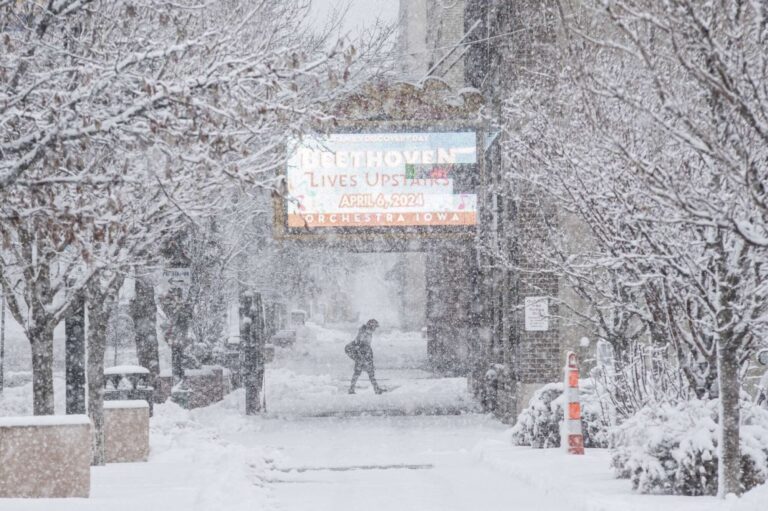Several winter storms have passed through the Midwest since the start of the year, bringing deep snow and bitter cold. In Iowa, where treacherous roads have caused hundreds of accidents, snow piled up to 20 inches in some places – marking a winter with 180% more rain than normal so far.
This week's storm reached as far as Memphis, where the mayor declared a state of emergency after 6 inches of snow snarled traffic and freezing temperatures caused at least two deaths. Meanwhile, schools and offices remained closed in New Orleans and Baton Rouge this week due to several days of sub-zero weather in the South.
The snow is coming after many years drought that has left parts of the Mississippi River basin with rainfall deficits of more than a foot.
Several more inches of snow are forecast in the Midwest this week. Next week, warmer temperatures will melt some of the recent snow and ice. As it melts, that water will bleed into parched waterways in Iowa and beyond, helping restore stream flows decimated by drought. It could also involve the risk of flooding downstream.

Most of Minnesota and northern Wisconsin are seeing below-average snowfall — a stark contrast to last year, when record snow led to Mississippi River flooding. The rest of the Midwest, however, is getting a flurry of above-average snowfall. Around a foot of snow covers eastern Nebraska into northern Illinois and southern Wisconsin.
Drought conditions usually do not improve in winter, as frozen soils cannot absorb precipitation. A warmer than normal December allowed rainfall to penetrate soils throughout the western corn belt. Parts of Iowa received more than double the average rainfall for the month. Drought conditions have improved in western Minnesota, Kansas and Missouri.
“That was really beneficial because the soils weren't frozen yet,” said Dennis Todei, director of the U.S. Department of Agriculture's Midwest Climate Hub. “A lot of it was able to soak into the soil.”
Winter storms that moved through the Midwest even dropped some rain in some parts of the Mississippi River Basin, particularly southern Illinois and Missouri, before the ground froze.

Winter weather warnings are in effect for the entire upper Mississippi River basin, and freeze warnings and watches cover the lower watershed. Much of the ground is frozen in the Midwest, so the soils cannot absorb the expected snowmelt next week. Water can help in another way, too: It can be fed into dried-up waterways along the basin.
Last summer's drought had cascading effects across the basin, including seawater intrusion that threatens drinking water in New Orleans, ongoing wildfires in Louisiana, and the river's challenges to agriculture and shipping.
Farmers reported difficulties in supplying water to their cattle last year. Public water supplies had to fall back on emergency procedures as their resources dwindled, such as in Iowa where one community considered using recycled wastewater as drinking water.
“We lack water in many places,” Todey said. “The lands are dry. The aquifers are dry. Lakes, lakes, rivers are all very dry. So the runoff is beneficial.”
Overnight lows should stay below freezing for much of the Midwest next week, which will keep some of the snowpack in place and prevent widespread flooding.

Melting may lead to some ice jamming—when clumps of river ice flow again—and localized flooding in the upper Mississippi River basin. Parts of Illinois were under a flood watch and warning as of the afternoon of January 18. However, in general, waterway levels are low enough to handle more water.
“That's one thing with this drought: We can get a flood of water in the inland streams and also in the rivers,” said Iowa State Climatologist Justin Glisan.
But the lower Mississippi River basin south of Cairo, Illinois, isn't likely to see much relief from Midwestern snowfall after months of drought.
Louisiana State University professor and former state climatologist Barry Keim said “it's a drop in the bucket.” But he said the extremely cold weather in the South brings a different form of drought relief: because moisture is frozen in the ground, the ground can't dry out even more.
Forecasters hope soil moisture levels across the region may see some relief in the spring. As the El Nino weather pattern continues through the rest of the winter, the upper US could expect warmer temperatures and more active storms over the next six weeks.
“We have some huge rainfall deficits that have accumulated, not just in the last year but in the last few years,” Todey said. “We want to see some improvements in those deficits before we start talking about a big drought improvement.”
Keely Brewer of the Daily Memphian and Eric Schmid of St. Louis Public Radio. Louis contributed to the report. This story is his product Mississippi River Basin Ag & Water Deskan independent reporting network based in University of Missouri in cooperation with Report on Americawith major funding from the Walton Family Foundation.

